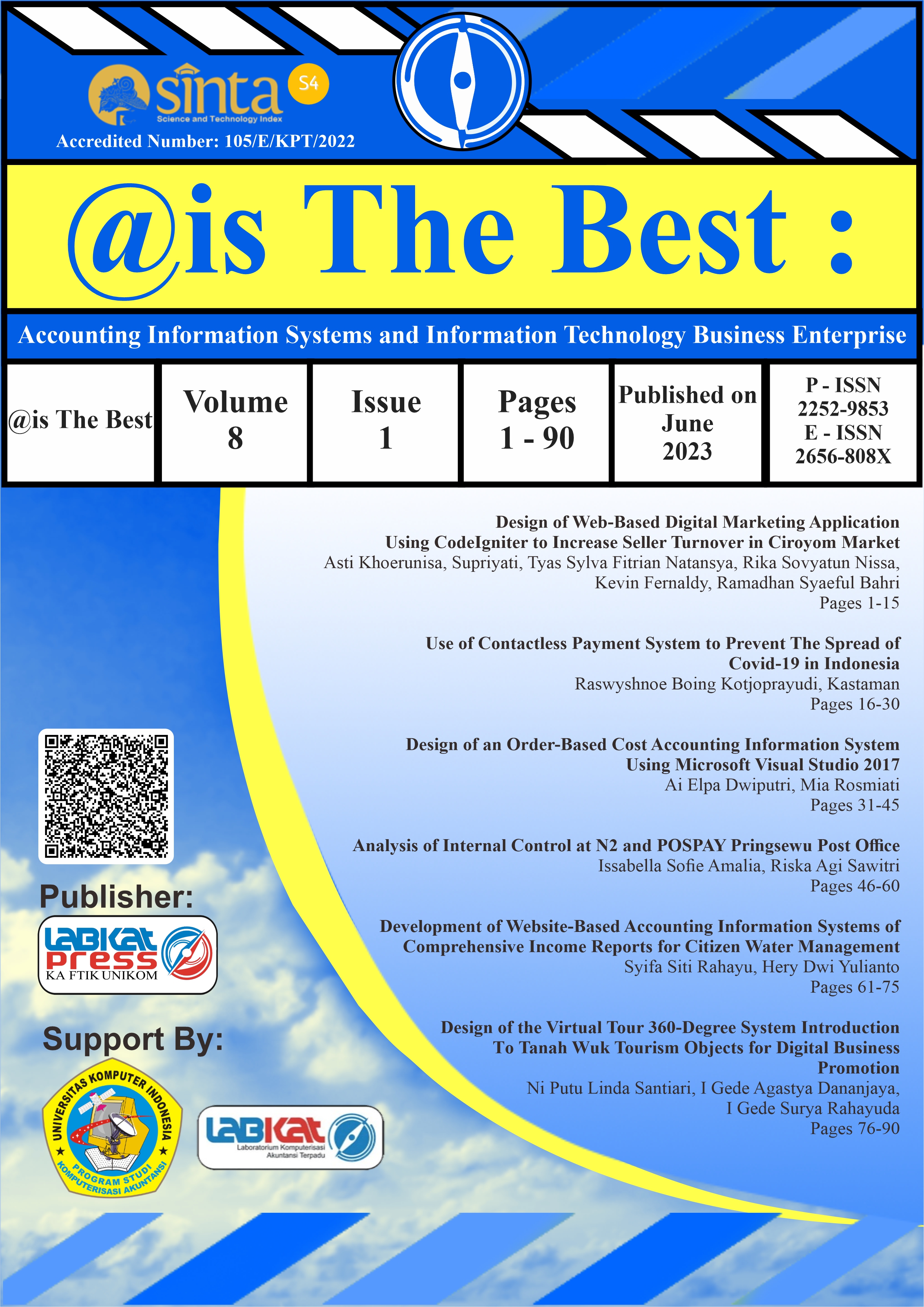Design of a 360 Degree Virtual Tour System: Introduction to Tanah Wuk Tourism Objects for Promotion in Digital Business
Main Article Content
Abstract
Tanah Wuk offers impressive views with the beauty of green valleys, a very calm situation, and rows of hills that complement this beauty. As a place for family recreation, Tanah Wuk provides a large enough yard that can be used as a place for barbecues and playing games with the family. Therefore, with the current development of information technology, one of which is packaging information technology through multimedia, we will increase the promotional media for Tanah Wuk Tourism Objects in Sangeh Village by creating a virtual tour application that aims to introduce Tanah Wuk Tourism Objects to tourists before visiting. Information technology, through this multimedia, is a combination of data, sound, video, audio, animation, graphics, text, and sounds in which the combination of these elements can be presented via a computer. Before being developed, the design needs to be done for this information system, starting with the menu structure design, storyboards, and interface design. System design is very important to ensure that the system built can provide significant added value for the users who use it. The design is carried out starting with data collection, needs analysis, menu structure design, storyboards, and interface design. From the needs analysis, there are two users involved in making this system, namely the admin and the user. For the menu structure, there are four menus in the system: home, profile, virtual tour, and about.
Downloads
Article Details
Section

This Journal is licensed under a Creative Commons Attribution-ShareAlike 4.0 International License
How to Cite
References
S. Supriyati, S. Mulyani, H. Suharman, dan T. Supriadi, “The Influence of Business Models, Information Technology on the Quality of Accounting Information Systems Digitizing MSMEs Post-COVID-19,” Jurnal Sistem Informasi, vol. 18, no. 2, hal. 36–49, 2022, doi: 10.21609/jsi.v18i2.1141.
D. Yanti, “Pengaruh Digital Marketing Terhadap Peningkatan Kunjungan Wisata Di Danau Toba The Effect Of Digital Marketing Toward Enhancement Tourist Visit In Toba Lake,” Khasanah Ilmu: Jurnal Pariwisata Dan Budaya, vol. 11, no. 1, hal. 16–26, 2020, doi: 10.31294/khi.v11i1.7607.
D. D. Beoang dan I. A. Suryasih, “Identifikasi Potensi Desa Wisata Sangeh, Kabupaten Badung,” Jurnal Destinasi Pariwisata, vol. 5, no. 2, Nov 2018, doi: 10.24843/JDEPAR.2017.v05.i02.p04.
S. Supriyati et al., Pengantar Ilmu Ekonomi. Eureka Media Aksara, 2022.
I. P. I. W. Pratama, I. N. Sukamara, dan W. Arimbawa, “Partisipasi Masyarakat Dalam Pengembangan Desa Wisata Sangeh Di Kecamatan Abiansemal, Bali,” PRANATACARA BHUMANDALA: Jurnal Riset Planologi, vol. 3, no. 2, hal. 136–155, 2022.
I. G. A. P. S. Mahendrayani dan I. B. Suryawan, “Strategi Pemasaran Daya Tarik Wisata Untuk Meningkatkan Jumlah Kunjungan Wisatawan Ke Daya Tarik Wisata Sangeh Kabupaten Badung Provinsi Bali,” Jurnal Destinasi Pariwisata, vol. 5, no. 2, hal. 240, 2018, doi: 10.24843/jdepar.2017.v05.i02.p09.
Supriyati, H. Suharman, dan T. Supriadi, “Business strategy and use of information technology toward ASEAN MSMEs performance in the post-pandemic crisis,” Journal of Eastern European and Central Asian Research (JEECAR), vol. 10, no. 5, hal. 886–897, Sep 2023, doi: 10.15549/jeecar.v10i5.1438.
P. S. Hasugian, “Perancangan Website Sebagai Media Promosi dan Informasi,” Journal Of Informatic Pelita Nusantara, vol. 3, no. 1, hal. 82–86, 2018.
A. Osman, N. A. Wahab, dan M. H. Ismail, “Development and Evaluation of an Interactive 360 Virtual Tour for Tourist Destinations,” Journal of Information Technology Impact, vol. 9, no. 3, hal. 173–182, 2009.
D. D. Prasetya, “Aplikasi Virtual Tour Berbasis Web Sebagai Media Promosi Pariwisata,” in Seminar on Electrical, Informatics, and Its Education, 2011.
M. Peruzzini, S. Cavallaro, F. Grandi, E. Martinelli, dan F. De Canio, “Exploring how to use virtual tours to create an interactive customer remote experience,” Journal of Industrial Information Integration, vol. 35, hal. 100509, 2023, doi: https://doi.org/10.1016/j.jii.2023.100509.
J. Cinnamon dan L. Jahiu, “360-degree video for virtual place-based research: A review and research agenda,” Computers, Environment and Urban Systems, vol. 106, hal. 102044, 2023, doi: https://doi.org/10.1016/j.compenvurbsys.2023.102044.
P. Palos-Sanchez, J. R. Saura, F. Velicia-Martin, dan G. Cepeda-Carrion, “A business model adoption based on tourism innovation: Applying a gratification theory to mobile applications,” European Research on Management and Business Economics, vol. 27, no. 2, hal. 100149, 2021, doi: https://doi.org/10.1016/j.iedeen.2021.100149.
M. Ingrassia, C. Bellia, C. Giurdanella, P. Columba, dan S. Chironi, “Digital Influencers, Food and Tourism—A New Model of Open Innovation for Businesses in the Ho.Re.Ca. Sector,” Journal of Open Innovation: Technology, Market, and Complexity, vol. 8, no. 1, hal. 50, 2022, doi: https://doi.org/10.3390/joitmc8010050.
T. Yang, I. K. W. Lai, Z. Bin Fan, dan Q. M. Mo, “The impact of a 360° virtual tour on the reduction of psychological stress caused by COVID-19,” Technology in Society, vol. 64, hal. 101514, 2021, doi: https://doi.org/10.1016/j.techsoc.2020.101514.
E. N. S. C. P dan I. Afrianto, “Rancang Bangun Aplikasi Chatbot Informasi Objek Wisata Kota Bandung Dengan Pendekatan Natural Language Processing,” Jurnal Ilmiah Komputer dan Informatika (KOMPUTA), vol. 4, no. 1, hal. 49–54, 2015, doi: 10.1109/ACCESS.2020.2976530.
A. Suryadi, “Perancangan Sistem Informasi Manajemen Kegiatan Sivitas Akademika Universitas Terbuka,” SISTEMASI : Jurnal Sistem Informasi, vol. 9, no. 1, hal. 116–130, 2020, doi: 10.32520/stmsi.v9i1.604.
F. J. Kaunang, “Analisis dan Perancangan Sistem Informasi Fasilitas Sekolah,” Jurnal Sistem Informasi dan Teknologi Informasi, vol. 7, no. 2, hal. 124–130, 2018, doi: 10.36774/jusiti.v7i2.247.
S. Supriyati dan D. Rizky, “Model Perancangan Sistem Informasi Akuntansi Budidaya Perikanan Berbasis SAK EMKM dan Android,” @is The Best : Accounting Information Systems and Information Technology Business Enterprise, vol. 3, no. 2, hal. 301–315, 2018, doi: 10.34010/aisthebest.v3i2.1526.

